Page 1 of 12: Survey of elementary geobiochemistry > the Lithosphere >
Chemical composition and structure of the Earth
Geobiochemistry Home

Origin of the chemical elements
|
Page 1 of 12: Survey of elementary geobiochemistry > the Lithosphere > Chemical composition and structure of the Earth |
|||||||||
|
Geobiochemistry Home |
 |
Origin of the chemical elements |
|||||||
The earth has been in a state of continual change since its formation. The major part of this change, involving volcanism and tectonics, has been driven by heat produced from the decay of radioactive elements within the earth. The other source of change has been solar energy, which acts as the driving force of weathering and is the ultimate source of energy for living organisms.
The solar system was probably formed about 4.6 billion years ago, and the oldest known rocks have an age of 3.8 billion years. There is thus a gap of 0.8 billion years for which there is no direct evidence. It is known that the earth was subjected to extensive bombardment earlier in its history; recent computer simulations suggest that the moon could have resulted from an especially massive collision with another body. Although these major collisions have diminished in magnitude as the matter in the solar system has become more consolidated, they continue to occur, with the most recent one being responsible for the annihilation of the dinosaurs and much of the other life on Earth. The lack of many overt signs of these collisions (such as craters, for example) testifies to the dynamic processes at work on the Earth’s surface and beneath it.
The earth is composed of 90 chemical elements, of which 81 have at least one stable isotope. The unstable elements are 43Tc and 61Pm, and all elements heavier than 83Bi.
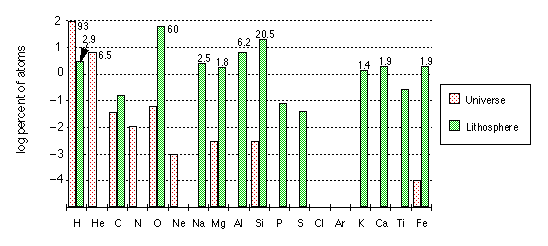
Note that the vertical axis is logarithmic, which has the effect of greatly reducing
the visual impression of the differences between the various elements.
The chart gives the abundances of the elements present in the solar system, in the earth as a whole, and in the various geospheres. Of particular interest are the differences between the terrestrial and cosmic abundances, which are especially notable in the cases of the lighter elements (H, C, N) and the noble gas elements (He, Ne, Ar, Xe, Kr).
Given the mix of elements that are present in the earth, how might they combine so as to produce the chemical composition we now observe? Thermodynamics allows us to predict the composition that any isolated system will eventually reach at a given temperature and pressure. Of course the earth is not an isolated system, although most parts of it can be considered approximately so in many respects, on time scales sufficient to make thermodynamic predictions reasonably meaningful. The equilibrium states predicted by thermodynamics differ markedly from the observed compositions. The atmosphere, for example, contains 0.03% CO2 , 78% N2 and 21% O2 ; in a world at equilibrium the air would be 99% CO2.
Similarly, the oceans, containing about 3.5% NaCl, would have a salt content of 35% if they were in equilibrium with the atmosphere and the lithosphere. Trying to understand the mechanisms that maintain these non-equilibrium states is an important part of contemporary environmental geochemistry.
Studies based on the reflection and refraction of the acoustic waves resulting from earthquakes show that the interior of the earth consists of four distinct regions. A combination of physical and chemical processes led to the differentiation of the earth into these major parts. This is believed to have occurred approximately 4 billion years ago.
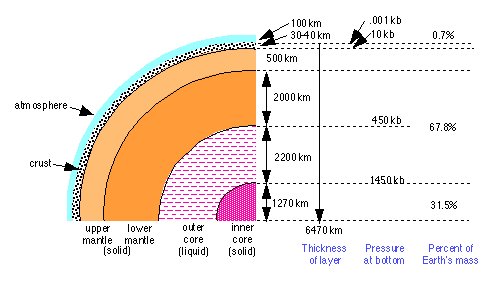
The Earth’s core is believed to consist of two regions. The inner core is solid, while the outer core is liquid. This phase difference probably reflects a difference in pressure and composition, rather than one of temperature. Density estimates obtained from seismological studies indicate that the core is metallic, and mainly iron, with 8-10 percent of lighter elements.
Hypotheses about the nature of the core must be consistent with the the core’s role as the source of the earth’s magnetic field. This field arises from convective motion of the electrically conductive liquid comprising the outer core. Whether this convection is driven by differences in temperature or composition is not certain. The estimated abundance of radioactive isotopes (mainly U238 and K40 in the core is sufficient to provide the thermal energy required to drive the convective dynamo. Laboratory experiments on the high-pressure behavior of iron oxides and sulfides indicate that these substances are probably metallic in nature, and hence conductive, at the temperatures (4000-5000K) and pressures (1.3-3.5 million atm) that are estimated for the core. Their presence in the core, alloyed with the iron, would be consistent with the observed density, and would also resolve the apparent lack of sulfur in the earth, compared to its primordial abundance.
The region extending from the outer part of the core to the crust of the earth is known as the mantle. The mantle is composed of oxides and silicates, i.e., of rock. It was once believed that this rock was molten, and served as a source of volcanic magma. It is now known on the basis of seismological evidence that the mantle is not in the liquid state. Laboratory experiments have shown, however, that when rock is subjected to the high temperatures and pressures believed to exist in the mantle, it can be deformed and flows very much like a liquid.
The upper part of the mantle consists of a region of convective cells whose motion is driven by the heat due to decay of radioactive potassium, thorium, and uranium, which were selectively incorporated in the crystal lattices of the lower-density minerals that form the mantle. There are several independent sources of evidence of this motion. First, there are gravitational anomalies; the force of gravity, measured by changes in elevation in the sea surface, is different over upward and downward moving regions, and has permitted the mapping of some of the convective cells. Secondly, numerous isotopic ratio studies have traced the exchange of material between oceanic sediments, upper mantle rock, and back into the continental crust, which forms from melting of the upper mantle. Thirdly, the composition of the basalt formed by upper mantle melting is quite uniform everywhere, suggesting complete mixing of diverse materials incorporated into the mantle over periods of 100 million years.
High-pressure studies in the laboratory have revealed that olivine, a highly abundant substance in the mantle composed of Fe, Mg, Si, and O (and also the principal constituent of meteorites) can undergo a reversible phase change between two forms differing in density. Estimates of conditions within the upper mantle suggest that the this phase change could occur within this region in such as way as to contribute to convection. The most apparent effect of mantle convection is the motion it imparts to the earth’s crust, as evidenced by the the external topography of the earth.
 |
Cross section of the crust and upper mantle. The dark- and medium-brown represent the continental and oceanic crust, respectively, while the light brown is the upper part of the mantle. Arrows show the direction of movement. Click on the link below for a more detailed description. From a Columbia U. course Web site of Prof. Paul Polson |
The outermost part of the earth, known also as the lithosphere, is broken up into plates that are supported by the underlying mantle, and are moved by the convective cells within the mantle at a rate of a few centimetres per year. New crust is formed where plates move away from each other under the oceans, and old crust is recycled back into the mantle as where plates moving in opposite directions collide.
|
This dynamic earth: the story of plate tectonics is an excellent, graphics-rich site maintained by the U.S. Coast and Geodetic Survey.
Click on the image at the right to see an expanded map of the world's crustal plates from the USCGS site. |
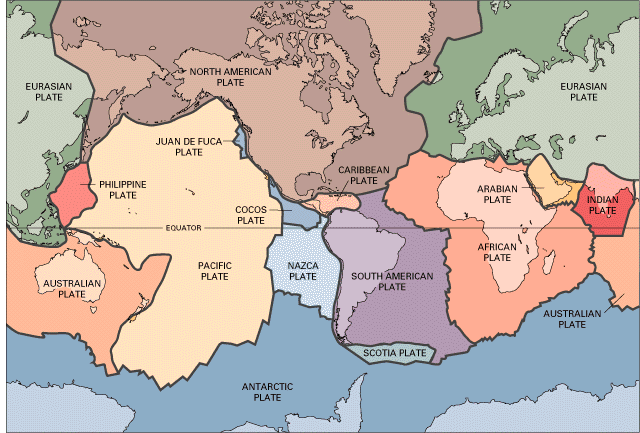 |
|||
The parts of the crust that contain the world’s oceans are very different from the parts that form the continents. The continental crust is 10-70 km thick, while oceanic crust averages only 5-7 km in thickness. Oceanic crust is more dense (3.0-3.1 g cm–3) and therefore “floats” on the mantle at a greater depth than does continental crust (density 2.7-2.8 ). Finally, oceanic crust is much younger; the oldest oceanic crust is about 200 million years old, while the most ancient continental rocks were formed 3.8 billion years ago.
| New crust is formed from molten material in the upper mantle at the divergent boundaries that exist at undersea ridges. The melting is due to the rise in temperature associated with the nearly adiabatic decompression of the upper 50-70 km of mantle material as separation of the plates reduces the pressure below. The molten material collects in a magma pocket which is gradually exuded in undersea lava flows. The solidified lava is transformed into crust by the effects of heat and the action of seawater which selectively dissolves the more soluble components. | |||||
 |
|||||
|
An animated view of seafloor spreading can be seen at the PBS site Mountain maker, earth shaker, which has a lot of good stuff on plate tectonics. |
|||||
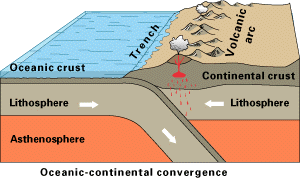 |
Where two plates collide, one generally plunges under the other and returns to the mantle in a process known as subduction. Since the continental plates have a lower density, they tend to float above the oceanic plates and resist subduction. At continental boundaries such as that of the North American west coast where an oceanic plate pushes under the continental crust, oceanic sediments may be sheared off, resulting in a low coastal mountain range (see here for a nice animation of this process.) Also, the injection of water into the subducting material lowers its melting point, resulting in the formation of shallow magma pockets and volcanic activity. Divergent plate boundaries can cross continents, however; temporary divergences create rift valleys such as the Rhine and Rio Grande, while permanent ones eventually lead to new oceanic basins. Collision of two continental plates can also occur; the most notable example is the one resulting in the formation of the Himalayan mountain chain. (See the USCGS Plate Motions page for much more about these and other diagrams.) |
||||
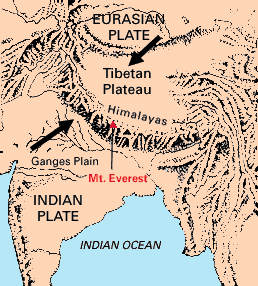 |
|||||
Page last modified: 21.01.2008